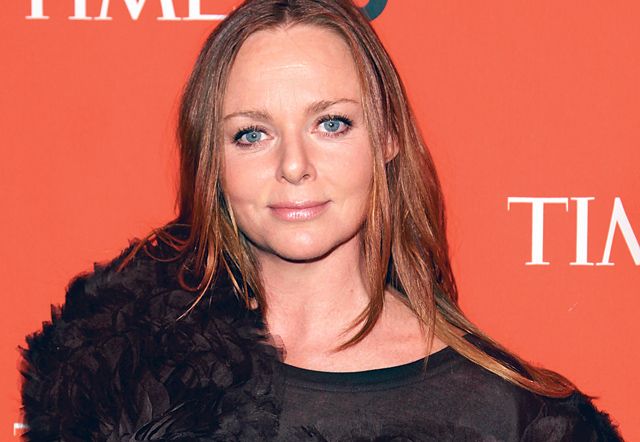Lunchtime in a fashionable cafe in west London, and a sleek young woman in an expensive ivory silk blouse and deftly cut black jacket smiles and asks the waitress what the soup of the day is.
"Pea and ham," comes the reply. The customer's smile fades. Stella McCartney leans her head to one side and narrows her wide, grey-green eyes. "Why do you have to put the ham in it?" she demands, her voice cool and low but fractionally louder than it was a moment ago.
The waitress, landed with the thankless task of defending pea and ham soup to one of Britain's most outspoken vegetarians, can only shrug and look mortified. McCartney sighs. "Oh, it's not your fault," she concedes, ordering scrambled eggs on rye toast instead. "But maybe next time, they could just leave out the ham?"
The true legacy, it seems, of an upbringing in the inner court of '70s rock aristocracy is less a penchant for sex, drugs and rock'n'roll than a trenchant respect for nature and a belief in vegetarianism. Right now, McCartney is a woman on a mission, her two passions having come together in a drive to encourage us to reduce our carbon footprint by cutting back on meat consumption.
As a fashion designer, she has spent 15 years trying to distance herself from the "Beatle's daughter" tag. But the moment I ask her about where her principles come from, all that changes. "The way my parents brought me up to see the world is still absolutely key to what I am about," she says.
"The beliefs I was raised with to respect animals and to be aware of nature, to understand that we share this planet with other creatures have had a huge impact on me.
"The idea of taking responsibility for what we take out of the earth... it's not something we sat down and had lessons in; as a way of thinking it came quite naturally."
Alternative though it sounds, Stella's upbringing sounds rather old-fashioned, in its way. The best piece of advice she was ever given, she tells me, was "do unto others as you would be done unto yourself. My mum and dad always said that and I don't think you can go far wrong with that."
Family values
With her watchful, heart-shaped face and red hair, she looks like a little smart-talking urban fox in skinny jeans. Today her hair is scraped back into a bun; she wears no jewellery except her wedding ring. Her skin is porcelain with a smattering of freckles and she is slender, almost fashion-skinny.
Of course the driving force behind the McCartney family's vegetarian tradition was Linda, who died of breast cancer 11 years ago. Stella adored her mother, and you sense that the fierceness of her principles is, in part, her way of honouring her memory. Earlier this year, Stella, her dad and her sister Mary launched the Meat Free Mondays campaign.
On a global scale, the meat industry generates nearly 20 per cent of man-made greenhouse gases more than the entire transport sector. The group Compassion in World Farming estimates that if the average UK household halved its consumption of meat, this would cut more emissions than if they cut their car use in half.
What's more, 50 million animals a year, says McCartney, are farmed, using vast amounts of energy, and killed for bags and shoes alone. Refusing to use leather in her work, McCartney has pioneered alternative fabrics for accessories. Pushing my leather handbag further under the table, I ask her why she thinks it is that the fashion industry not only ignores her protests on fur and leather but is also (it seems to me) backward in terms of environmental thinking. (The bi-annual, transatlantic tour of catwalk shows is starting to feel about as de rigueur as a patio heater.) Are people in the fashion industry particularly heartless?
"Yup," she says. "People in fashion just don't want to hear the messages. I find it astounding, because fashion is supposed to be about change I mean, we're supposed to be at the cutting edge! I can only think they don't care as much as people in other industries. So, yes, I think people in fashion are pretty heartless."
McCartney has experienced some of the venom of the fashion industry at first hand. By recruiting family friends Naomi Campbell and Kate Moss to model at her graduation show from Central St Martins in 1995 she made an instant name for herself, but put more than a few backs up.
When she was hired just two years later as head designer at Chloë, the knives came out. Even Karl Lagerfeld went on record to mock the appointment. Quietly, however, she made a success of Chloë by showing a shrewd understanding of what young women would want to wear next, and never compromising on a sexy, flattering fit.
Chic fashion
After four years, she struck a deal with Gucci, who agreed to her own Stella McCartney label.
The first Stella McCartney show, in the autumn of 2001, was a car crash, however. One particular T-shirt, emblazoned with the word BRISTOLS, is scorched on my memory. Trashy and vulgar, a world away from the chic trousers and jackets her Chloë customers loved her for, the collection was universally panned. What happened?
"Oh, God. Everything was wrong. It was all a bit messy. I was still finding myself as a person and I was trying to find myself as a brand too quickly. I was nervous and I was over thinking things..."
After that bruising first season, McCartney returned to a less showy, more subtle aesthetic. "Things got better when I started being more true to myself. I like doing slightly masculine, Savile Row tailoring. A nice jacket. Wearable it's almost a dirty word in fashion, wearable, but that's what I do. And yeah, it can get a bit boring, but I can push it each season into something better and more relevant for that season."
In 1997, the Stella McCartney label turned a profit for the first time, meeting the target set by Gucci group. McCartney has found her place in the fashion firmament by largely bypassing trends in favour of skilful, wearable interpretations of the silhouette and the mood that is shaping how women want to dress at that moment.
"When I first started out, American buyers would come to see my clothes and I'd show them a jacket and trousers and they'd be like, ‘What's the full look? What's the blouse, what's the shoe? What does the customer wear with this?' And I'd be like, ‘Er, whatever they want?' They thought I was a bit odd. But that's changed. These days the customer makes her own decisions more. "
In March, McCartney was honoured with an award for her support of environmental causes by the Natural Resources Defence Council. Accepting the award, she said: "I try to avoid this kind of recognition because it can pigeonhole you. It's my job to make people not notice that I'm working in a slightly more responsible way." Why, I wonder, the ethics-by-stealth?
"I am a fashion designer. I'm not an environmentalist. When I get up in the morning, number one I'm a mother and a wife, and number two I design clothes. So the main thing I need to do is create, hopefully, exquisitely beautiful, desirable objects for my customer. That's my job, first and foremost. If I can make you not notice that it happens to be out of biodegradable fake suede, if I can make you not notice that it hasn't killed cows or goats or unborn baby lambs, then I'm doing my job. And sometimes... I try really hard, but if now and again I have to dye a bag using chemicals that are not as low in environmental impact as I'd like, in order to get a brighter colour, then I will do that."
When I ask her, genuinely curious, whether the people who work for her would ever eat, say, a bacon sandwich in the office, and she snaps at me for asking "a Daily Mail question". No, I'm just genuinely curious, I say.
"Do they? I don't know. I assume they do. I don't think about it. Sometimes, at lunchtime, I can really smell fish when people are eating, and then I'll shout OK guys, enough fish. My argument is, if a journalist comes into our office and it stinks of fish, that's weird." She doesn't have much of a sense of humour about the vegetarian thing, but then, why should she? It's not a joke to her.
After her latest collection is done and dusted — the catwalk show took place in Paris recently — the next project to emerge will be a capsule collection for Gap Kids, which goes on sale in November.













